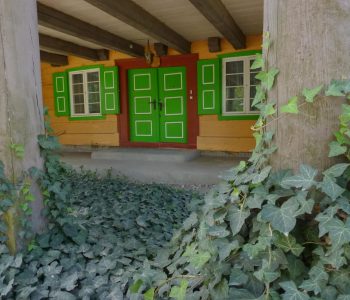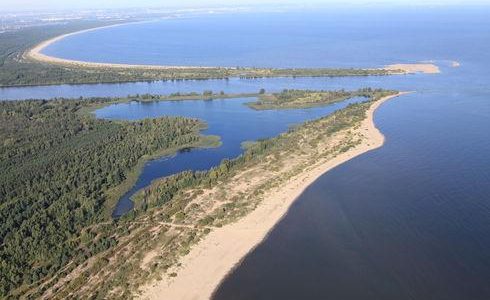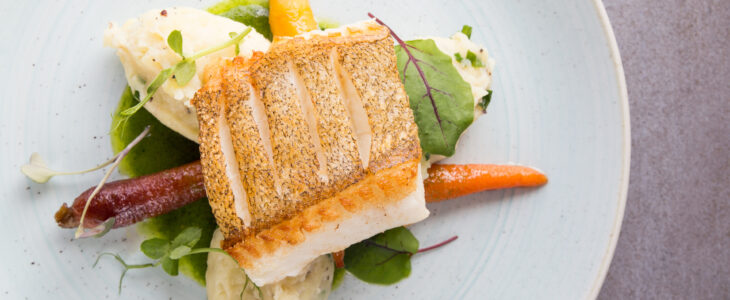Zalew Wiślany

Zalew Wiślany, fot. M.Bieliński
On the north-eastern edge of the Pomorskie Region, we reach a place which, despite its obvious holiday advantages, hides a true bird phenomenon.
The Zalew Wiślany – in English the Lagoon was formed a few thousand years ago when offshore Baltic shoals formed a sand spit that separated the sea from the lowland areas of Żuławy. Today this bank is known as the Mierzeja Wiślana – the Vistula Spit. The lagoon, with its specific hydrographic conditions and thick surrounding vegetation, is enamoured on an enormous scale by wild birds – some species like to pass this area on their migrations, while others make use of the friendly environment and take care of their chicks. It is worth seeing with your own eyes this ornithological melting pot.

Kormoran nad Zalewem Wiślanym, fot: PKMW
The lagoon is, perhaps most importantly, one of the biggest European nesting sites of the great cormorant, a beautiful and ravenous bird, which around 100 years ago was in danger of becoming extinct. Today, throughout the year, huge colonies of this species lead their lives in this area. The lagoon is also a nesting site for, among others, the grey heron, red-crested pochard, greylag goose, common shelduck, shoveler, great crested grebe, black-headed gull, Savi’s warbler and sea eagle. Over 150 species nest in the lagoon, as well as in lake Drużno nearby, including eurasian bitterns, little bitterns, white storks, garganeys or teals. Moreover, species such as the smew, greater white-fronted goose, bean goose, northern pintail, tufted duck, common pochard or little gull, migrate to, from and through places along the lagoon.
The mosaic of bird species present on the area of the Zalew Wiślany [Vistula Lagoon] changes with the seasons. Spring, for example, is a mating season for birds, so it is the most colourful time of the year –particularly attractive areas to watch birds are Zatoka Elbląska [Elbląg Bay] and the mouth of the Pasłęka river. A mandatory point of any visit is meeting cormorants in their refugium in Kąty Rybackie. You can easily spot herons too, as they nest in great numbers at various sites. A visit to the west side of the reserve in spring involves an amazing concert – provided by birds (like the spotted crake, eurasian bittern, little bittern, warbler) emitting specific mating sounds – which will immediately get your attention.

Czapla biała nad Zalewem Wiślanym, fot: W.Woch
After the spring frolic, the activity of the winged inhabitants of the lagoon drops. Summer is for them mainly a time to calmly nurture their chicks. Birds tend to be almost invisible and more scared than normal during that time. Only around September can we spot the first aerial adventures of the young travellers in the sky. The next bird shows can be observed during autumn. It is of course a time of migration – the perfect time to buy yourself binoculars or a telescope and set out to the lagoon to watch many migrating species on the one hand and, on the other, birds that are arriving slowly to their winter quarters. The majority of birds gather in the Kanał Elbląski [Elbląg Canal], in the bay near Kąty Rybackie and in the area of the mouth of the river Nogat’s. A great idea is to observe mass migrations from the hills in the neighbourhood of Piaski and Krynica Morska on the Vistula Spit. Winter is also a rewarding time for observers and photographers of birds’ lives. Big flocks of water birds often overwinter near the lagoon, including Canada geese, an invasive species which originates from North America. The organization of the bird menagerie is influenced by the conditions that last during the winter. During warmer seasons we can count on bigger amounts and diversity among the winged winterers.

Ohar – mieszkańcy Zalewu Wiślanego, fot. I.Florczyk
No matter which season you plan to visit the Zalew Wiślany [Vistula Lagoon], it is important to remember about proper clothing, paying special attention to footwear – wellingtons, waders, or even fishing trousers really do make it easier to look for wild birds in the vast acres of rushes. The area of birds’ nests can be explored thanks to local bicycle trails stretching near the refugium’s borders. With a minimal dose of luck and proper preparations, you can observe wildlife as well as go on a decent bike ride. An interesting proposal is, for example, the route Krynica Morska to Kąty Rybackie (16 km), stretching across much of the Spit. To the west from Krynica, between Przebrno and Skowronki, is a fine viewpoint over the Zatoka Gdańska [Gulf of Gdańsk]. Another one, which allows for observation of the west coast of the lagoon, can be found in the area of the mouth of the Wisła Królewiecka river.














